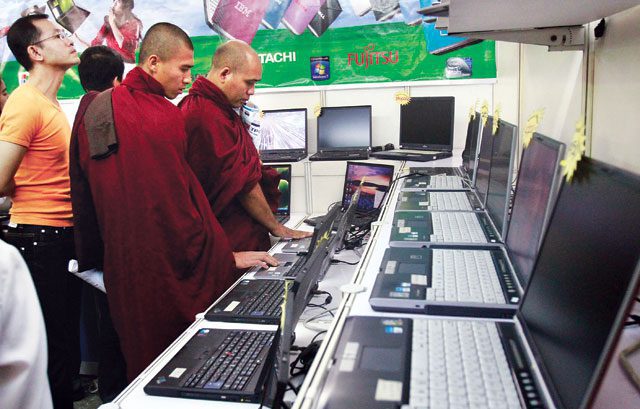The young Myanmar couple laugh as they lay in each other’s arms under an umbrella beside Yangon’s peaceful inner-city Kandawagyi Lake. It is a display of affection common in Myanmar, but where the young couple’s parents may have taken to gazing across the rippled green water, these two prefer less whimsical gazing and more smartphone action, joining the soaring number of young locals taking to social networking sites such as Facebook.
As Myanmar assumes the Asean chairmanship in 2014 – for the first time since becoming a member of the bloc in 1997 – foreign investors are betting that, with reform, the country could become a golden land of opportunity for business, particularly when it comes to the internet.
One Vietnamese-Canadian is taking this bet and putting her money where her mouth is. In June, Rita Nguyen launched Squar, Myanmar’s first social networking site.
Facebook, as in many other Southeast Asian countries, has already permeated almost every facet of public and private life in Myanmar for an increasing number of users – from government officials to grassroots non-profits. Yet Nguyen’s concept for Squar aims to bring something new to the social media mix – a site in the Myanmar language, for Myanmar people.
“Burmese nationals have access to Facebook, but they don’t have access to connect to it in their own language,” Nguyen explained.
Squar is a social networking platform that is anchored by various interest groups. Users build profiles and gravitate towards those groups that appeal to them in order to find others who share interests in, or concerns about, a given topic.
“This is a virtual destination for you to make friends with those who are already connected, as opposed to coming online and finding existing, real-world friends,” Nguyen said of the site’s concept.
In just six short months, there are already hundreds of online community groups blossoming on Squar. These groups are centred on topics as varied as photography, parenting, design and dental health. Users comment, share tips and interact in chain-like conversations similar to Facebook status updates.
“We are building our features largely based on what the community is asking for, effectively letting them build a social network that works best for them,” Nguyen said.
Formerly an executive with Electronic Arts, Nguyen worked on the development of the video game company’s online marketing, community and social media teams when Facebook and Twitter did not exist as the global phenomena they are today. At that time “the concept of social media was not part of the common vernacular”, she said.
Later, Nguyen returned to her Vietnamese roots and worked with the co-founders of the leading social networking site mig33, which boasts over 70 million users in developing markets such as Nepal, Syria and Bangladesh.
“With Myanmar’s economic and political reforms underway, I knew that there would be a unique opportunity to build and engage with youth of this new market in a meaningful way,” she said.
Reform, especially media reform, has drastically altered the way Myanmar people receive and share information. For many generations under military rule, the rumour mill in Myanmar was in permanent overdrive. Fuelled by strict media censorship, government micromanaging of official information and an entrenched teashop culture, rumours have long held a special place in the psyche of Myanmar people. Word of mouth was often the only way information could be disseminated among citizens while the government maintained an iron grip on media. With the relaxation of both censorship and the government’s control of media, the public’s bubbling desire for information has exploded in the form of dozens of new news sources, both in print and online.
It is no wonder, then, that the people of Myanmar have also taken so quickly to social media. Previously, exiled journalists frequently used Facebook as a means to disseminate information under the austere censorship framework that was not lifted until 2011.
“Facebook has essentially become synonymous with the internet in Myanmar, where internet users are roughly equal to those who have Facebook accounts,” said John Handley, chief executive officer of Sail, Myanmar’s first and largest advertising company.
Founded in 1991, Handley’s company has recently expanded its operations by launching a digital arm of its advertising portfolio. “Mobile is the future, especially in developing countries where technologies are leapfrogging the conventional path,” he said. “Our digital initiatives aim to align with this trajectory.”
Handley said that in his experience, TV is still the most effective medium for communicating with Myanmar consumers, but that the quickly changing mobile market is offering new opportunities.
“Social media will likely not be as effective [for advertising] until online banking becomes a learned and trusted tool,” he said. “Then, industries such as e-commerce will make online advertising much more viable.”
Some companies are already diving into social media to facilitate brand launches in Myanmar’s expanding commercial market. As part of its landmark launch in the country, Coca-Cola paired with Squar for its “Happiness” campaign to promote its 300-kyat (about $0.30) Coca-Cola products. While the company created its own Facebook page to connect with Myanmar’s growing number of users, it paired with Nguyen’s site with a focus on long-term campaigning and information sharing – trends rooted in the rumour mill society of the dictatorship years.

Social media entrepreneur Eric Oo believes in this rumour-mill society. He said that, as companies vie for a slice of Myanmar’s blossoming middle class, social media marketing could overtake traditional billboard and print campaigns in terms of effectiveness.
“Myanmar people love social media,” said Oo, who has been granted a fellowship to develop Myanmar’s first social media-based public relations firm. Oo believes that Myanmar’s burgeoning love of technology is not only the way into people’s minds, but into their wallets as well.
“There are a lot of [commercial] companies coming here,” Oo said. “Social media marketing in both [English and Myanmar] languages is something new for Myanmar.”
For Squar, those who look set to be influenced by such marketing are users who fall into a younger demographic – a group with more disposable income and a keener attention to emerging trends.
“Unsurprisingly, we are attracting mostly youth (18- to 35-year-olds) and a slightly more male skew over female,” Nguyen said. “Given the large population of youth in Myanmar, this is what I expected. That said, we’re just getting started and also hope to create experiences that will appeal to people who are older than 35.”
The free flow of public information is exploding in Myanmar, where the shackles of censorship are gradually being loosened. Some 20 newspapers have launched since publication licensing was liberalised, and the blogosphere is expanding at a similarly exponential rate. Squar users, too, have taken quickly to the influx of information that is coursing through the veins of social networks.
“Technology removes barriers to communication and Squar leverages that to encourage discussion and debate on topics of interest, hopefully also enhancing learning and education,” Nguyen said. “We have also noticed that our community really likes to share their own poetry and art, so it looks like Squar is also sparking creativity among the youth of Myanmar.”


